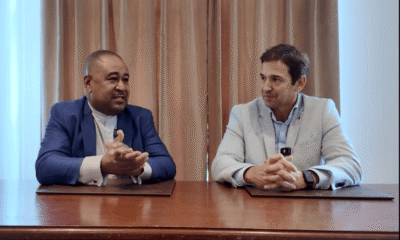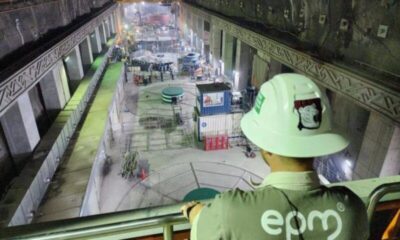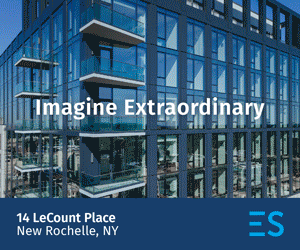Interview: Glencore’s Cerrejón Director Makes the Case for the Coal Mine’s ESG Efforts in Colombia
Many people, including Colombian President Gustavo Petro, like to beat up on what’s left of the coal industry. But few realize that coal is still an essential fuel for energy production —and will remain so until later stages in the global energy transition.
The Cerrejón coal mine owned by Switzerland-based Glencore, is the largest economic actor in Colombia’s La Guajira department in the far Northeast of the country near the Caribbean Sea and the Venezuelan border. The open-pit Cerrejón mine has had its share of controversy, with many local people, including the indigenous Wayúu opposing the mine, while others support it and depend upon it for their livelihoods.
During the 2024 Minexpo mining industry event organized by industry trade group Asociación Colombiana de Minería, or the Colombian Mining Association, Juan Carlos García Otero took the time to speak with Finance Colombia’s Executive Editor Loren Moss for a brief but intense interview where nothing was off limits.
Garcia, who is Cerrejón’s social affairs manager, spoke about the mine’s record regarding social and environmental responsibility, touching upon coal’s role in the global energy transition.
Loren Moss: Well, I am here with Juan Carlos García Otero. Thank you for your time. Here we are at MinExpo in Medellín. Tell me about your role and about the company you represent.
Juan Carlos García: Thank you so much, Loren. My name is Juan Carlos García Otero, I am the social affairs manager at Cerrejón. My area is in charge of securing the social license for operating our mine on La Guajira, for the benefit of all the people in that department, but also of the people in this country.
Loren Moss: Well, Cerrejón is, I think, the largest operating mine in Colombia. It’s a coal mine in La Guajira. Tell me, how many employees do you have?
Juan Carlos García: Look, maybe I should clarify that our measurement is not necessarily based on the size. The biggest and most important thing we have, that we are sure of, is that when it comes to people we are the largest. Why? We have over 12,000 employees, between direct ones and contractors, who are linked to the company and make all the development of their own lives and families through the mining operation in Cerrejón. So, in that sense, we are strongly convinced of the importance and significance it has for the department that that work connection happens.
Loren Moss: Because it’s the largest powerhouse in that region of Colombia — from Valledupar to the Atlantic coast — I cannot think of a company with more local economic impact. Tell me please, in general terms, about the importance for the economy of department capital Riohacha and La Guajira.
Juan Carlos García: Cerrejón represents between 55%-60% of the department’s gross domestic product. In that sense, we are a fundamental cornerstone of the development of the region. But we also signify over 105 billion Colombian pesos in social investment that we have done throughout last year through commitments and voluntary and mandatory executions.
We have had over 60 million liters of water delivered to a region that still needs additional efforts in order to provide water for the whole population, and in which we have increased in the last year almost 50% of that volume that we delivered.
We are a fundamental part, with over 11 billion pesos delivered in taxes and royalties, which represent almost 50% of what is delivered by the entire mining industry in Colombia. And in that regard, we leverage the whole country’s development in a fundamental way.
In that sense, I think we truly are protagonists of the development of the region and of Colombia.
Loren Moss: I visited the area on a trip. I was not there for anything related to your company but I stayed at your hotel. That hotel is wonderful — with a view of the mine in the distance. Really, it’s like the best hotel in the region. We went to visit Manaure. Anyway, another thing I noticed when we visited some rural villages — some Wayúu people — is that there was not even a mobile signal or electricity. You are not the power company and you are not the phone company. But apart from the employment and everything, can you tell me about the contribution you offer to the region?
Juan Carlos García: Look, a few things to tell you: The first is that the hotel is not ours, we promoted the arrival of investment for that hotel to be built, and we have a small participation that serves a social purpose in its development. We are basically leveraging tourism, we are strengthening the development capabilities of the community from that area, so that they can get to know the region — besides the existence of Cerrejón. La Guajira is a department worth getting to know, and we are aware that we need to make contributions and to leverage others’ investments to make that happen.
Now, you said you got to know communities, and you say they are not related to us. But they are! And, actually, if you look at exhibits at this exposition, we can see there are communities that we have brought here. Because part of our effort is to generate capabilities and development so that those cultural, productive, and employment activities can happen in the department. And so that people can offer their products in a direct way with better commercialization. So, what we do there is strengthen those capabilities.
When it comes to development, our contributions are focused on facilitating that the different actors — governmental in this case, when we are referring to energy matters — can carry out their functions. In that regard, we have been part of the solution, contributing with our assets to problem-solving, like in the case of Uribia. At this moment, we have some preliminary agreements that allow us to facilitate the access to Cerrejón’s power line, for the improvement of the power in that municipality. And in Manaure as well.
Additionally, we have facilitated our resources to achieve the connectivity of a very important area, the harbor area and Cabo de la Vela, to the national electrical system. If that construction had not been done with Cerrejón’s assistance, those communities would probably not have achieved that — or not have been on the path to attaining such development — through the ultimate entities responsible, the state and the local operator.
So, what do we do? We incorporate ourselves into the solution. We are aware that we are not the solution. But we are more aware that we are part of the solution that can be achieved in La Guajira.

The entrance to 2024 Minexpo, the largest annual gathering for the mining industry in Colombia. (Credit: Loren Moss)
Loren Moss: Well, you are doing really necessary work. It’s needed. There are many places that depend on coal, but long-term, in many places — including the president here in Colombia — they do not see it as an ultra-long-term thing. What is your position as a producer of a product that is necessary now for the short and medium term? And when talking long-term, what is your plan as a company? What is the long-term environmental plan, so it can be successful as a business — but also make long-term contributions with everything that‘s changing in the environmental setting?
Juan Carlos García: I understand. Look, I think that you are touching on many variables that would not be responsible of me to address. Because I am not the one managing them. I am not the one managing the world’s energy matrix. I am not the one who defines how the production of energy will be managed — or how it will be managed in other places.
I cannot give you an answer in that sense. But what I can make totally clear for you is that we, today, have a commitment — and it is to make the most of the entire Cerrejón operation from the standpoint of the people. Meaning, on the basis of the people being able to understand the opportunity that a mining operation represents in an area that needs development. And we need to leverage that effort so that they, when coal stops being part of their reality definitively — a part of their environment — whenever that may happen, they have the alternatives. They will have visualized the options and have built a future leveraged on this reality today that allows us to help them the way we do.
Loren Moss: Here at the event, at MinExpo, we have members of the Wayúu community. Some are producers of dairy, artisans, and musicians. As a big sponsor at this MinExpo event, tell me about the activities you do to promote the development of not only the Wayúu people, but also for all the people who live there in the local area and La Guajira?
Juan Carlos García: Well, look, I believe you would need a show with many episodes for me to tell you everything. But I am going to tell you about only some of the things we do, and I will try to do a run through things we have here.
I want to start off with the musicians. We have an orchestra here, and we do a great amount of work so the guys stay away from vices — from drugs, from activities that are not positive — and connect with music from the point of view of their tradition and their culture. We try to make it possible for music to be a job alternative, like it is for over 50 guys who have been in the orchestra and today do that job professionally. That is part of what we believe in.
We also support sports. We have a huge commitment to strengthening football [soccer] — a sport that is valued and appreciated in La Guajira — and of a championship that we sponsor — and from which [Colombian and Liverpool FC superstar] Luis Díaz came out. You’ve probably heard of him and he has been in those championships.
We continue to believe that strengthening those spaces is useful — not only because of what it signifies, like stories as important as Luis’ — but for the amount of people that distract themselves with sports and what it represents for their lives and their health.
We support enterprises. We support companies. We have companies that develop their company objectives through the direct hiring from Cerrejón so that they are able to generate economy, employment. and sustainability — as well as gain experience in the world of business and trade. They learn hand in hand with a company like Cerrejón.
Then there the artisan crafts. A few years ago, the artisans only produced the supplies, and they would sell it to third parties that were the ones earning the profits. We have been working on strengthening the designs, strengthening entrepreneurship, strengthening the capabilities — and that allows them to make the sales themselves. We take them to every fair event that we can, and they make their own sales directly. That has led, for example, to them surpassing over 100 million pesos in sales last year at the Expoartesanías fair in Bogota.
We have also worked on the culture. We build hand in hand with the communities, including Wayúy and black people in that territory, and that is are very valuable and they teach us very important things. But we also need to highlight their language, their traditions, understand them, and co-exist with them.
That is just part of what we do. Here, at the fair, we have brought only a small sample. But, without a doubt, if we get the chance we can tell you about it in greater detail later on.
























